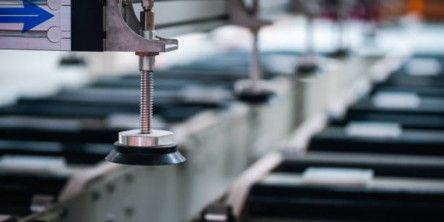Machining Process and Applications of Sapphire
Sapphire is a form of the material Alumina (Aluminium Oxide – Al2O3). It is often considered a precious gemstone. Sapphire is the single crystal form of alumina used in engineering ceramics. Its single crystal structure has no porosity or grain boundaries. Saphire products have a measured density which is close to the hypothetical value for pure Alumina material.
Sapphire gemstones are naturally occurring materials, frequently besides another form of pure alumina, ruby. However, they differ in color from each other. Synthetic sapphire has been available since 1902 after its discovery by the French chemist Auguste Verneuil. He heated alumina powder at high-temperature flame which resulted in subsequent deposits, in the form of a ‘lump’ of the material.
Detail about Machining Sapphire
The need of sapphire has drastically increased as all other materials have been exhausted. It also has unique properties. As a result, when sapphire is required, the difficulty occurred not in the selection of the material but rather in the ability to create the part in a configuration which is valuable and useful.
During the machining sapphire process, material is grounded to an appropriate size and tolerance and finely polished so that the material will be useful as planned. This process creates lots of difficulties in manufacturing challenge, it is always recommended to machine sapphire under experts’ supervision in order to succeed.
Properties of Sapphire:
Due to the hardness of 2,200 Hv, sapphire is wear and scratch resistant. It has various indicative physical and mechanical properties which lead to a wide range of industrial uses.
Industrial Applications of Sapphire
Electronic Substrate Applications: Sapphire is an attractive substance which can be produced in comparatively large dimensions. It is inert and can be machined at high temperatures. It is often used as a material for the epitaxial deposition of Gallium and Silicon Nitride.
- It can be used for insulating substrate applications in high-frequency, high-power CMOS integrated circuits. Often denoted as a Silicon on Insulator “SOI” or silicon on sapphire or "SOS" chip.
- As a substrates for the growth and deposition of Zinc Oxide nanowires and carbon nanotubes
In Display Devices: Sapphire can be used as a material for premium transparent watch face, however it has many other display type applications:
- FLIR (Forward Looking Infra Red) optics and sensor devices.
- Sapphire windows can be used in both short and long wavelength environments (Ultra Violet and Infra Red).
- Used in devices where corrosion resistance and high temperature is required.
- POS (point of sale windows) for bar code scanning.
Sapphire in Cutting Tools and Mechanical Components: Stiffness, high hardness and single crystal structure lead to use of sapphire material in many engineering or industrial components. Some examples are:
- Analytical equipment applications are common areas where the strength and transparency is vital. In many applications the resistance of sapphire to phosphoric or hydrofluoric acid is also significant.
- In aerospace applications, for windows manufacturing as sapphire has a high degree of impact erosion. Sapphire windows are mainly preferred choice due to the higher scratch resistance.
- Nozzles in water jet cutting and sandblasting.
Medical Applications of Sapphire
Due to the load bearing capabilities, fine microstructure, and light transmission qualities of sapphire present interesting options to the medical component designer:
- Systems using laser transmission and surgical tips.
- In endoscopic inspection tools, sapphire is often used as a window material.
- The fine microstructure of sapphire combined with polishing and skilled machining techniques produces cutter edges and ultra fine blade.
- Sapphire is also non- thrombogenic (does not causes blood clots).
- Biomedical implants used in dental applications.
- Used in making cosmetic laser surgical devices and powerful pulsed lights
- In making surgical mirrors and filters
- Sapphire lenses can be used in imaging applications, laser optics, and sapphire medical optics.
Similar Articles
CNC Machining has emerged as a vital technique in the current production process, as it provides an efficient and accurate means of manufacturing items with complex geometries. This technology is applied across aerospace, automobile, and medical devices manufacturing fields, and various other industries.
Find out what to look for in a reliable CNC machining manufacturer, from quality assurance and advanced technology to customer service, for efficient project success.
Save on pipe relining costs with smart planning. Learn how to reduce expenses through targeted repairs, material choices, off-peak scheduling, and competitive bids.
When it comes to metalworking, the quality of your equipment can make a significant difference in the efficiency and accuracy of your projects. Among the essential tools in any metalworking shop is the sheet metal brake, which plays a crucial role in bending and shaping metal sheets
Discover the latest design trends and innovations in metal table legs, enhancing style and functionality for modern interiors.
In the dynamic nature of the industrial sector, high-efficiency gate valves play a crucial role in the flow control system. Leading valve suppliers and globe valve suppliers are always engaged in the development of this technology to enhance the efficiency of the equipment.
When it comes to constructing a metal building, whether it's for industrial, commercial, or residential use, choosing the right metal building company is crucial. Metal buildings offer durability, flexibility, and efficiency, but only if they are designed and constructed correctly.
Discover how ERP systems streamline procurement in manufacturing, enhancing efficiency, reducing costs, and improving supplier management.
In today's fast-paced manufacturing landscape, the use of high-quality bonding solutions, such as industrial adhesives, has become increasingly crucial to ensure product quality, efficiency and competitiveness.









